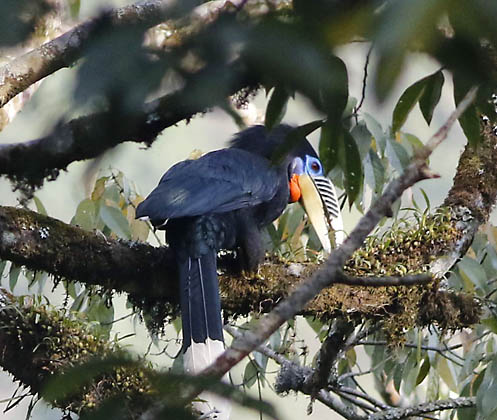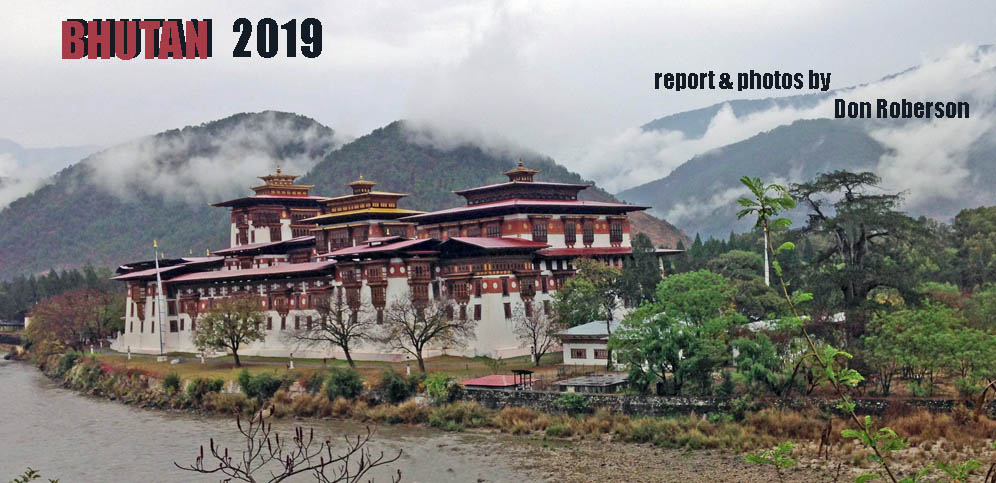
 |
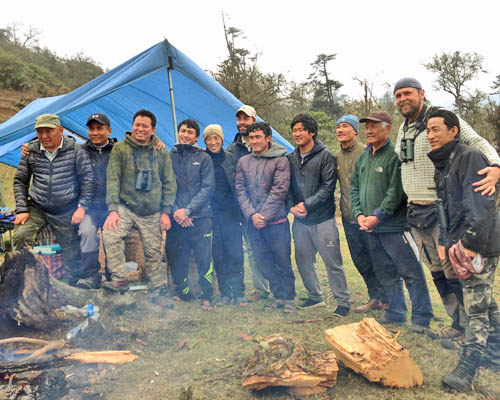 |
This is a gallery of photos and bits of commentary from 18 days in Bhutan during Mar-Apr 2019. I was a participant on a Rockjumper tour
that took in all the major habitats of the country, led by David
Erterius, André Bernon, and local guides Tsherinz, Jigme, and
driver-guide Tenzin. There were 10 participants, and we traveled a
transect of Bhutan, east to west, in a large bus over the ever-winding
roads of this mountainous country. Most roads, like shown above left,
are in steep terrain with a cliff soaring upwards on one side and a
deep drop-off on the other. As we camped on six nights (in 3 different
camps), and had a hot lunch in the field most days, it took a crew of 7
Bhutanese, along with the local guides, to care for us (above right).
Our two Rockjumper guides join our crew in this photo (above right):
David (from Sweden) is the tall one on far right, and Andre (from South
Africa) is in the white cap in the center. We also visited Bhutanese
historical and cultural sites, including the famed Punakha Dzong (title photo above).
March was a bit early in the season for some
high-elevation species, and it had been a late spring anyway. We saw
most of the high-elevation birds downslope as altitudinal migrants. We
targeted Bhutan's most exotic and famous birds, and found most targets
among the ~340 species recorded by the group. [I personally recorded
320 birds; I expect Rockjumper Tours will post its own trip report in
due course.] At the trip's conclusion we all picked out "top 10"
highlights from Bhutan. Here is an overview of my "top ten" highlights, a bit modified here to emphasize those supported by photos.
#1 Fire-tailed Myzornis Myzornis pyrrhoura
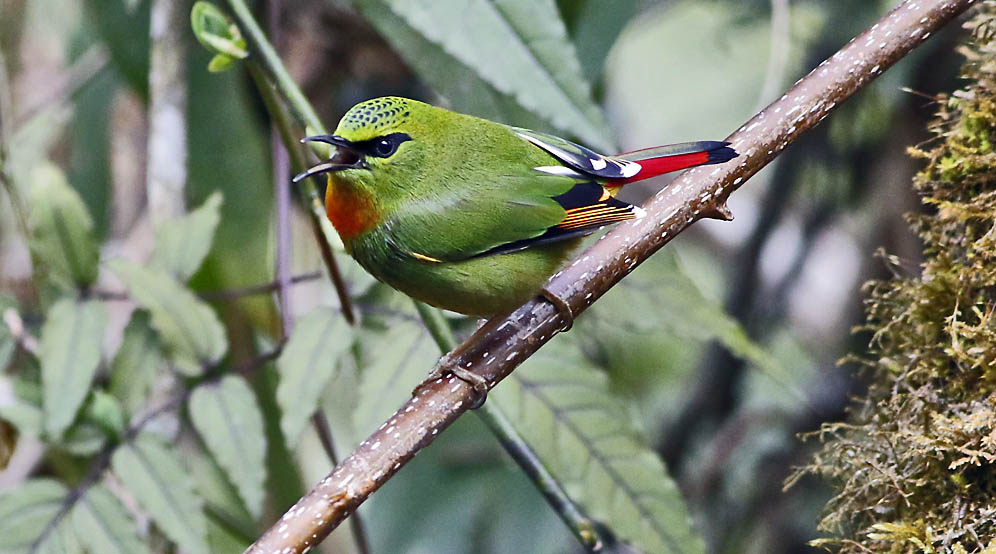
| A specialty of the subtropical forests in the Himalayas, this spectacular little bird is little known and remains mysterious. There was talk at one time that Fire-tailed Myzornis might be entitled to its own monotypic family, but current research places it in the Paradoxornithidae with some fulvettas and parrotbills. This male was reacting to a playback of 'chatter' calls made by small birds mobbing small owls. The Myzornis even went into a wing-spreading display during the short frenzy in search of the nonexistent owl. Then, as stealthily as it had appeared, it was gone. It had initially been #4 on my pretrip "want list" but its performance boosted it to my #1 bird of the trip. |  |
#2 Himalayan Monal Lophophorus impejanus 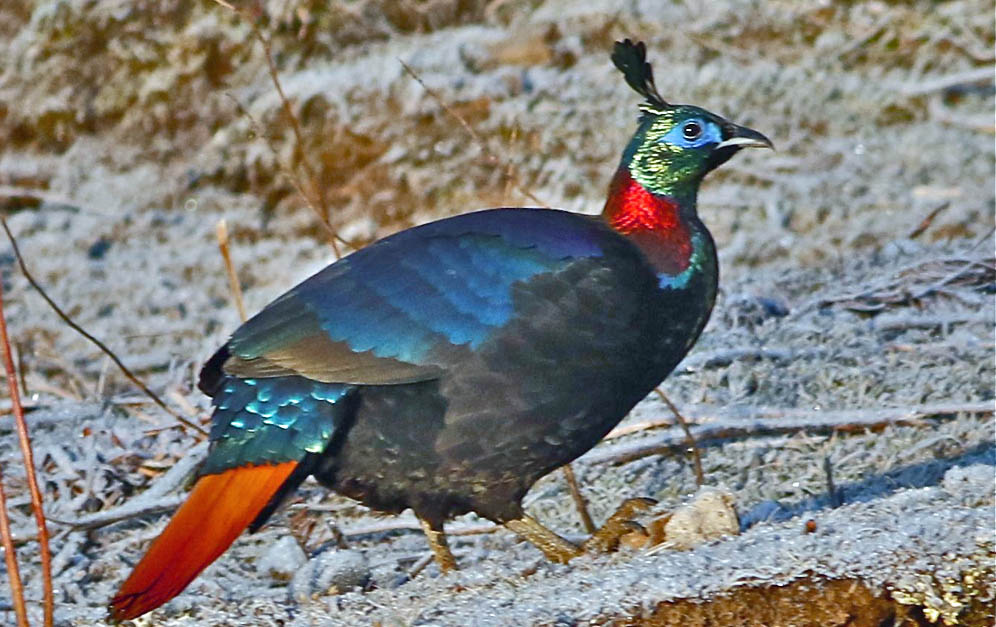
| On our final full day of the trip we all got up at 3 a.m. for a 4 a.m. departure to the high forest and treeline tundra on Chele La, at 3800m (12,550' elev.). This is as high as one can drive on a paved road in Bhutan. We were told that we had to be the first vehicle on that road at dawn, as the otherwise shy Himalayan Monals feed in the snowfields just then. Chele La did not disappoint, and we saw 3 males and a female from our bus. All our views and photos were taken from the bus windows to avoid disturbing these impressive pheasants. This had been my pre-trip #2 target, and our fine success in the crisp morning air was very satisfying for what was the final lifer of the trip. | 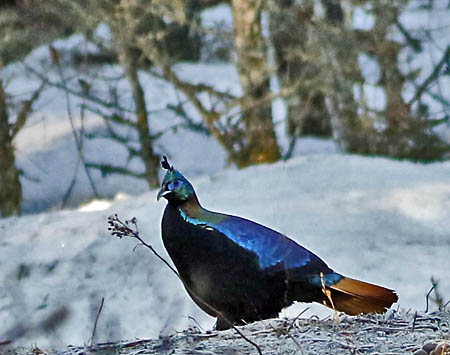 |
#3 high-elevation sunbirds
Fire-tailed Sunbird Aethopyga ignicauda

and Mrs. Gould's Sunbird Aethopyga gouldiae
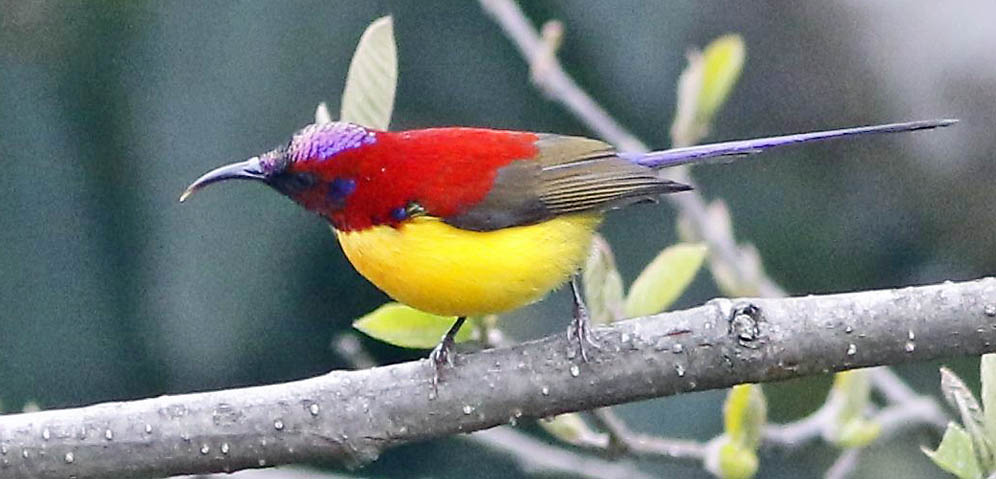
My actual #3 pick was Spotted Elachura Elachura formosus — seen but not photographed. Once thought to be a wren-babbler, it was elevated to Family level on molecular evidence in 2014 [see my Family page on Elachura]. Because it was a Family that I 'needed,' it was my pre-trip #1 target. We worked hard on two singing skulkers before I actually saw the 3rd and final bird when it ran across this bit of undergrowth (right)... I just missed taking a bad photo of it. Instead I showcase two stunning male sunbirds from high elevations in Bhutan: Fire-tailed Sunbird, which breeds in alpine scrub (we saw down-slope migrants just twice), and Mrs. Gould's Sunbird, a montane species that also winters lower (we saw about 8 males). Elizabeth Gould, a prolific artist in her own right, helped illustrate multiple bird books authored by her husband, John Gould. The sunbird is named for her, and is a stunner. |
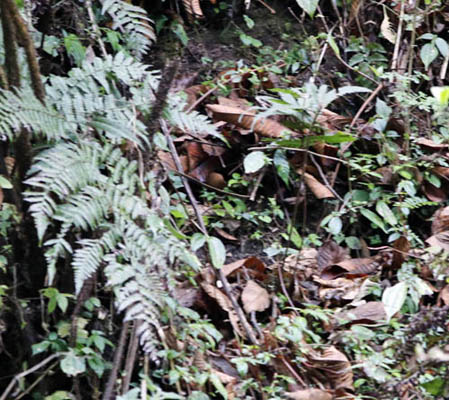 |
#4 Blood Pheasant Ithaginis cruentus
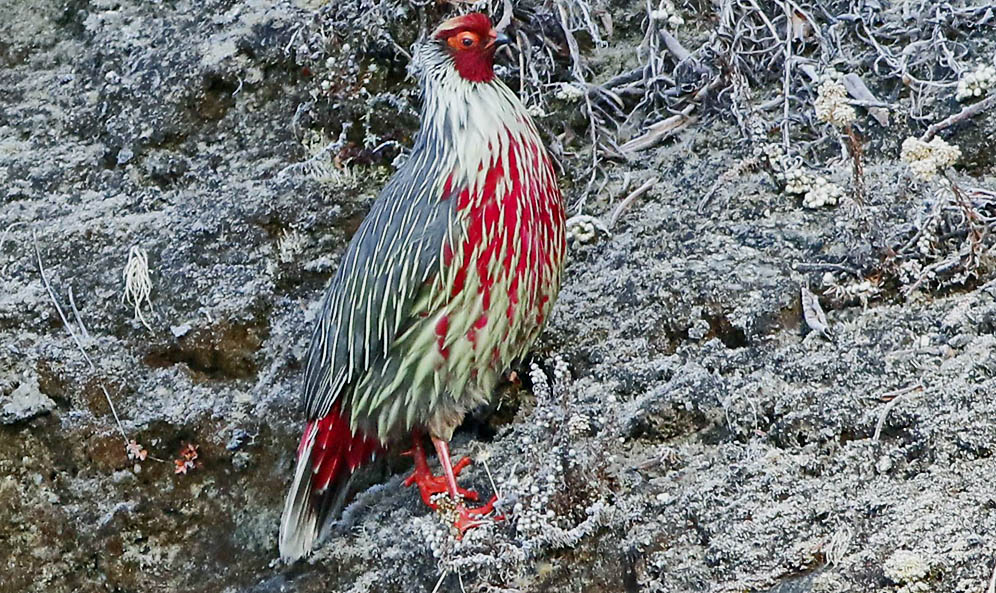
| Another gorgeous pheasant — Satyr Tragopan Tragopan satyra
— was actually my #3 pre-trip target in Bhutan, and we did see it
twice, but photos were not possible. We saw a fine male Tragopan
downslope in thick bamboo, and another from our bus at dawn on the
roadside that slipped away quickly. It was a disappointment not to
obtain photos of such a wonderful bird. But we were fortunate to see the very lovely Blood Pheasant at roadsides at high elevation several times, including the male shown here. It was not a personal lifer — I'd seen a pair before in China but before I had a digital camera — so it was quite gratifying to photograph this species. This male was foraging early on a frosty morning below the pass at Thruming La at 3660m (12,000' elev). |
#5 Beautiful Nuthatch Sitta formosa
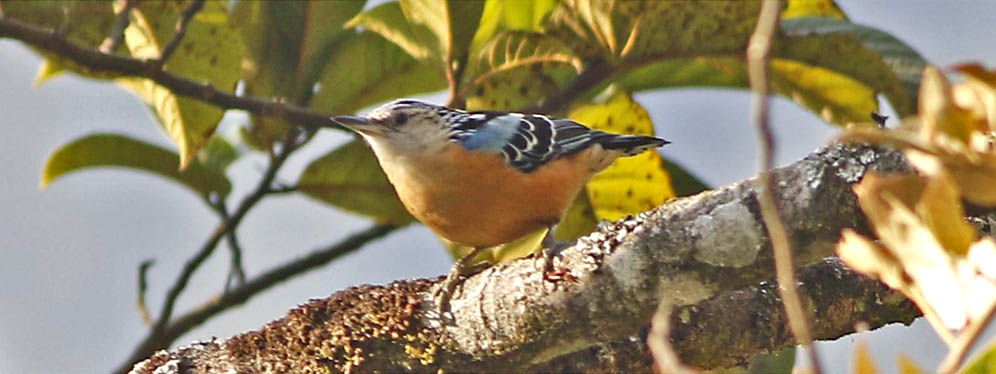
| In many respects the Beautiful Nuthatch is the flagship bird of Bhutan. The Monal and Satyr Tragopan might compete for that title, but their range is more widespread in the Himalayas. Bhutan is the primary core range of this large and colorful nuthatch. It is scarce within its broadleaf evergreen forest habitat. It was our chief focus during the first couple days of the trip in the subtropical zone. We found four of them above our Morong camp. | 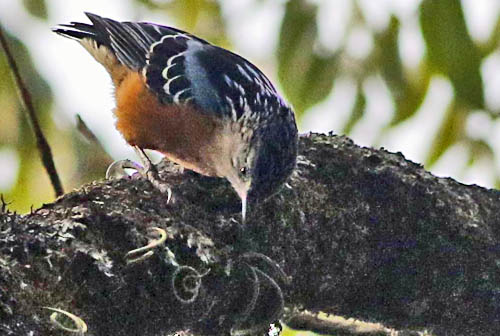 |
#6 Ward's Trogon Harpactes wardi

| Ward's Trogon is another Bhutan specialty with limited range in the subtropical zone of the Himalayan range, and a major pre-trip target. It gets to ne India and n Myanmar but those are difficult places to visit. For most world birders, Bhutan is the only choice. It took us 3 days in habitat along the Lingmethang Road before our local guides found us a pair well upslope from the road. These are large trogons but the red-bellied male (photographed) and the yellow-bellied female were surprisingly difficult to spot in the twisted, moss-covered trees that towered upslope. The best experience for me was seeing the male in flight, showing the extensive pink outer rectrices. It is the only "pink" trogon on earth. |
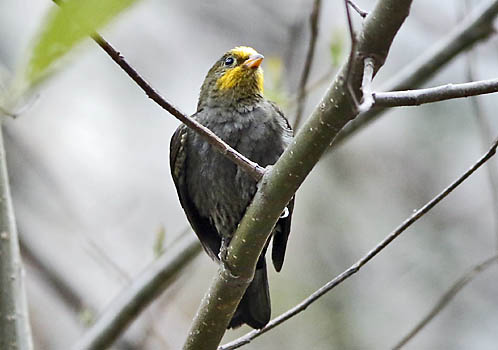 |
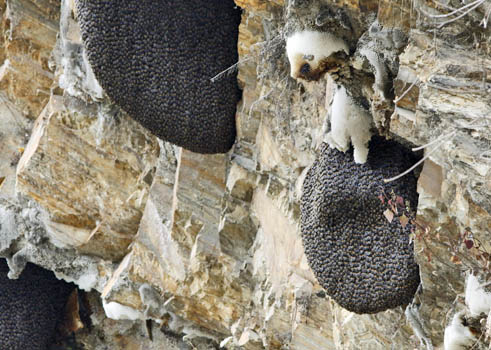 |
| I've
long been fascinated by honeyguides, Family Indicatoridae. It's an Old
World family. There are 15 species in Africa but only two in Asia, and
I'd not seen either of the Asian honeyguides before this trip. We found
them at two locations, and both were near steep overhanging cliff-faces
that held large colonies of rock bees (above right; Apis dorsata, sometimes called "giant honeybee"). Research reveals that a colony may hold up to 100,000 bees. Yellow-rumped Honeyguide has zygodactyl feet, with two toes facing forward and two backwards. They perch on honeycombs and feed on wax. Some articles state that males tend to be territorial and stay near honeycombs while females and youngsters forage widely. They are brood parasites, laying their eggs in the nests of tree-hole breeders, often barbets. I counted 7 honeyguides around the hives on our visit, including females, as I watched (and photographed) copulation! (backlit photo at right). |
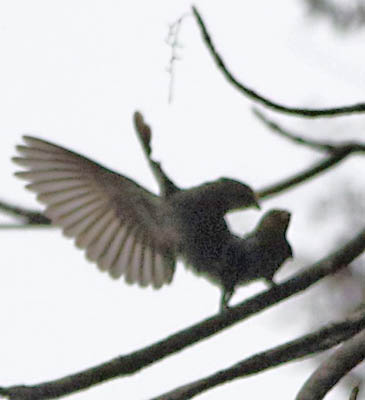 |
#8 Rufous-necked Hornbill Aceros nipalensis
female (left) and male (right)
|
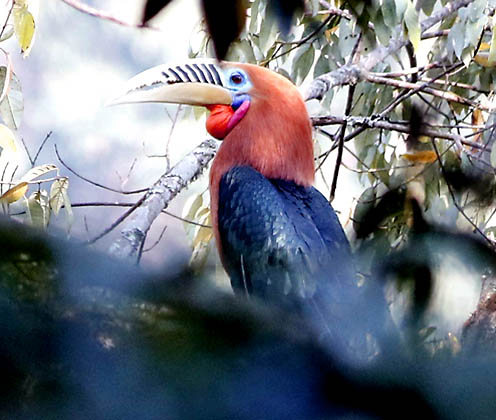 |
| These huge hornbills are another range-restricted species, inhabiting Bhutan, ne India, and n Myanmar. The range of Rufous-necked Hornbill is a bit more extensive than Beautiful Nuthatch or Ward's Trogon but still they are found in subtropical forest in only a limited slice of the Himalayan Range. There are five top-of-the-line "big hornbills" in Asia: four in genus Buceros and just this one in genus Aceros. For me personally, this completes the set. As is apparent from these photos, only the male has a rufous head and neck. |
#9 White-bellied Heron Ardea insignis

| The White-bellied Heron is probably the most endangered heron on earth. The IUCN lists it as Critically Endangered, with an estimated population of adult individuals at just 50-249 birds scattered along undisturbed rivers or wetlands from the eastern Himalayan foothills of north India and Bhutan to northeastern Bangladesh and Burma. It is mostly solitary and is threatened by disturbance. We spent all afternoon near Royal Manus NP scoping the edges and backwaters of the Mangde Chhu River before Jigme finally spotted this solitary individual from a high overlook. This is cropped from my digiscoped effort; Lee Alloway, Ann Flood, the Walshes, and the guides all got better shots with superior equipment. We all felt very lucky to see this one, certainly the rarest bird globally of any other bird seen in Bhutan. |
#10 undergrowth skulkers
Chestnut-headed Tesia Cettia castaneocoronata (top)
Rufous-throated Wren-Babbler Spelaeornis caudatus (bottom)


| It
often seems it is impossible to see any wren-babbler, let alone
photograph a wren-babbler or similar undergrowth skulker. On this tour
we had hopes to see the Elachura (see box under pick #3 above), two
Cupwings, three Wren-Babblers (in two families), and three Tesias (in
two genera). If one is on your own in the right habitat, you might
spent hours stalking these nearly invisible mites. On tour, one is
relegated to hopes they respond to a judicial snippet of tape. We did
eventually see Elachura (but no photo), did see Scaly-breasted Cupwing
well (I wasn't carrying my camera), did see Bar-winged Wren-Babbler
well (I totally messed up the focus), and had untickable views of
Long-billed Wren-Babbler and Pygmy Cupwing. Yet I managed these
marginal shots of Chestnut-headed Tesia (after multiple tries) and Rufous-throated Wren-Babbler (sharpened in PhotoShop). We dipped on the other two Tesia species. Personally I am enamored with undergrowth skulkers — including pittas, ant-pittas, antthrushes, and gnateaters inhabiting tropical understories around the globe — and each is a challenge and a joy (if seen). This was a good trip for skulkers (which can include some parrotbills and babblers here) but still, of the 9 most difficult, I saw just five well enough to enjoy and I got marginal photos of two. I had untickable views or dipped on the remaining four. |
page created 26-28 Apr 2019 |
© Don Roberson |
